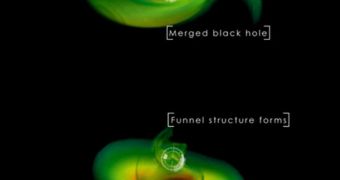While scientists believe that gravitational waves will be detected within a few years, no one is claiming that this will be easy. In order to make the goal more accessible, a team of investigators recently produce a computer simulation meant to predict what telescopes will see when they detect these waves.
According to the theory of general relativity proposed by Albert Einstein, massive bodies that interact or merge with each other produce gravitational waves, which are basically distortions in spacetime that propagate through the Universe at the speed of light.
These waves have massive amplitudes, which means that they could not possibly be detected from an Earth-based facility. The only solution is to use a satellite constellation whose spacecraft are located very far apart from each other, but can communicate instantly.
NASA and the European Space Agency (ESA) were working together on such a network, dubbed the Laser Interferometer Space Antenna (LISA), but the Americans announced last year that they will not continue their involvement, due to budget limitations.
If LISA is launched by the Europeans, it will feature three spacecraft arranged in an equilateral triangle, the sides of which will measure at least 5 million kilometers (3 million miles). The distance between the satellites will be measured with great precision, using a technique called laser interferometry.
Until then, computer simulations will provide scientists with the data they need. As more information about the behavior of black holes becomes available, they will be included in the models to refine the measurements even further.
“Black holes orbit each other and lose orbital energy by emitting strong gravitational waves, and this causes their orbits to shrink. The black holes spiral toward each other and eventually merge,” explains John Baker, an astrophysicist at the NASA Goddard Space Flight Center (GSFC), in Maryland.
To run the new simulation, experts used the Ranger supercomputer at the University of Texas in Austin, as well as the Discover supercomputer at the GSFC Center for Climate Simulation.
“We need gravitational waves to confirm that a black hole merger has occurred, but if we can understand the electromagnetic signatures from mergers well enough, perhaps we can search for candidate events even before we have a space-based gravitational wave observatory,” Baker explains.
Thus far, potential signs from gravitational waves have only been detected from white dwarf binary systems, which feature pairs of helium-burning stars.

 14 DAY TRIAL //
14 DAY TRIAL //